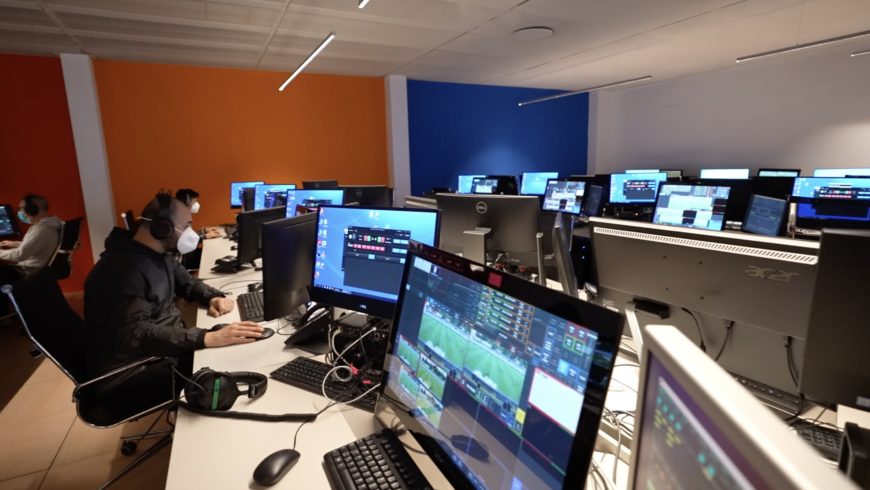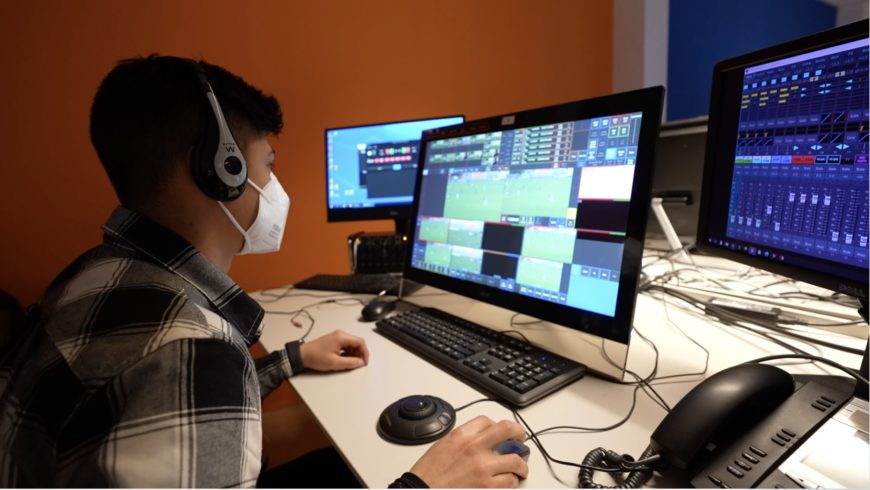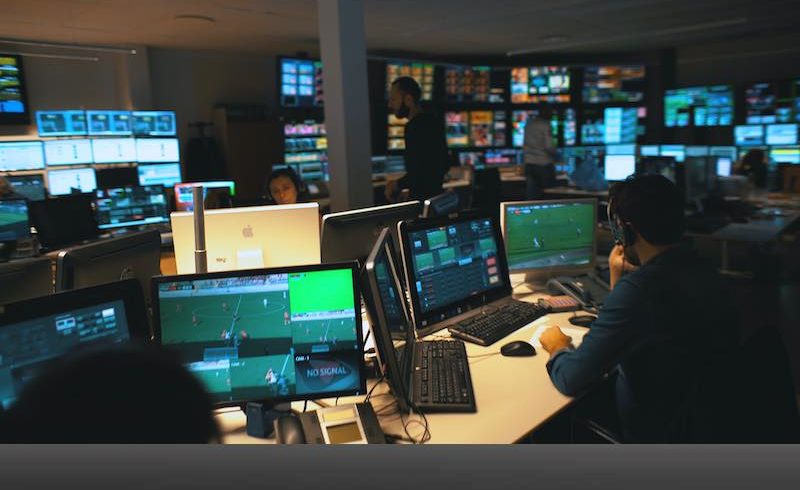EMG Italy
- EMG Global
EMG Countries
- EMG Belgium
- EMG France
- EMG Germany
- EMG Netherlands
- EMG USA
- EMG United Kingdom
EMG Brands

by Roberto Landini
The Indoor Technical Operation of EMG Italy is the department that deals, among other things, with "Remote Production" or "tv production from a remote venue", a practice that involves personnel in the field, commensurate with the production plan, and technical equipments connected in a bidirectional way to remote operational structures already existing in the broadcast production center.
This procedure is nothing new for EMG: it started several years ago as pioneers, long before the pandemic, thanks to cutting-edge technical structures, today it is considered as consolidated also for Italy and perfect for television production, especially in sports and in different disciplines.
Expressed in this way, this concept is however very reductive, given that, in fact, RP has much wider possibilities and, despite having started in the broadcast and media area, especially television and video, today it involves many other markets.
The demand for remote production is stable and growing from adjacent sectors such as corporate, educational, industrial, cultural, where different workflows that started in a pandemic, today more modern and more in step with the times, must respond to new needs for flexibility and commitment, truly commensurate with resources.
Broadcast center and production site
The Remote Production theme really allows you to change the way content is produced and distributed and is particularly valid for OTT digital distribution platforms.
Even yesterday’s problems in the evolution of this model, such as the availability of bandwidth and the obligatorily low latency, are now worries of the past.
IP networks today are efficient, cost-effective for the production model and allow even complex production models to be carried out.
The same troupe can easily move between different locations in a short time (also due to the very short setup times and use of small mobile vehicles) and therefore optimize logistics; the final product still enjoys all the quality guaranteed by the same production center that uses centralized broadcast equipment capable of managing high-level and cost-effective productions.


REMI
Remote production or "REMI", Remote Infrastructure, today also known with different meanings and variants, such as Remote Operation, Remote Distributed Operation and others, is made possible by the latency, now very low and by the availability on the market of equipment of adequate cost, as complete mini-control rooms and high quality H265 encoders operating on optical fiber, on Wi-Fi and on telephone radio links.
In addition to the ability to perfectly adapt the technical structures used based on the real scope of the event, there is an increase in the production workflow, which is much more streamlined, and therefore the possibility of producing more monetizable content on today's multi-platforms.
Born for minor events, today the RP is really adequate for any meeting and level of production; therefore, from the "covid context", many variants have evolved today with many advantages, also thanks to new levels of security, content encryption, latency and bandwidth availability through optical fiber and radio frequency on 4G and 5G.
EMG Italy has been on the market for years with many remote productions in Italian Serie C Football that we deal with in these pages, but also in Volleyball, Beach Volleyball and Basketball and more that we will address in a future study, shortly.
Speaking of basket and remote production, EMG Italy has recently won an important contract for the next three years.
Enrica Busin, head of the MCR & Playout, tells some details about Lega Pro Calcio Serie C:
“The Italian Serie C football championship involves 60 teams with as many as 30 matches every weekend for round matches.
EMG Italy takes care of all these productions remotely and, depending on the standard that is required, the commitment can be single-camera, double or tri-camera.
The connections between the production "venue" and the broadcast center are certainly crucial in this configuration and the various crews use a large number of equipment.
These are devices known as “backpacks” which, connected to the cameras, use a proprietary protocol to transfer high quality signals. The signals are transported simultaneously using 4G and, where present, the IP network."


Mono and bi-camera
EMG Italy, for several years, has been using a wide range of equipment for transmission and reception of signals.
The backpacks for the acquisition and transport of live signals, which have been in operation for years, now include the newer models in the Pro version, which can use up to 8 internal SIMs from different telephone operators.
Every weekend over 30 of these backpacks are hired on the field in all of the three production standards.
On the playing field, in addition to the cameramen, there is always at least one commentator, usually placed in the stands.
All the video signals, the audio of each camera, and the audio of the journalistic commentary arrive at the MCR of EMG Italy in Cologno Monzese.
The layout of the cameras is quite static and provides, in the mono-camera, a camera that takes wide-angle shots of the whole field, positioned in the stands.
In the bi-camera configuration, both cameras are on the stands at the top: the first takes wide-angle shots with wide fields, while the second deals with narrow fields and game details.
Tri-camera
In the tri-camera configuration, the third camera moves on the sidelines; therefore, he adds even more engaging images and often also deals with the integration of additional clips captured in the pre and post game.
The commentator journalist is usually placed in the press area or in a special commentary booth, where available, depending on the configuration of the stadiums which, of course, are much simpler than those of the A and B series.
Its set usually includes only a headset with a headset microphone and the dedicated audio coder.
Sometimes in tri-camera configurations, and at least once every weekend, a double audio commentary with the second pitchside commentator is also required.
In the integration, there are 2 commentators in position plus a third on the sidelines.
This complicates the setup a little, which also requires the presence of a special sound engineer, with an audio mixer.
The set-up
Convened about two hours before the match, the operators take care of the assembly of the stands and cameras, the set-up of the commentary station, make the fiber connections on pre-existing cables that allow a backup link (the network connection is carried out on the backpack with Ethernet cables) and start the backpacks with the main 4G connections.
The signals arrive at the MCR in one of the two EMG Italy offices (the one in Cologno Monzese, the other is in Milan) where the video and audio integrity is checked and the colorimetry is checked and corrected in the bi and tri-camera setups.
In the headquarters of the production center, for each game, a special dedicated “producer” directs each event thanks to a system that takes care of the audio and video mixing functions and integrates the graphics signals.
At the same time, it allows you to broadcast the highlights of the game through live replays, using the same signal being recorded.
In the tri-camera configuration at the stadium are created: 1 video signal with 2 ambient audio signals + comment (single or double).
All these signals are carried by the backpacks and received by other devices called Stream Hubs.
Grafica e MCR
Serie C is broadcast on Eleven Sports' OTT, with 8 games per weekend three and two-camera.
All the graphics, created internally by the Boost Graphics specialists of EMG Italy, are integrated into the live from each of the 25 control stations that deal with the C Series.
Every weekend about ten matches are held on Saturdays and twenty on Sundays, so in addition to the staff in the MCR room, 10 “video mixer” specialists are hired on Saturdays and 20 on Sundays in the various control stations.
Stefano Branduardi part of the Indoor Technical Operation team declares:
"I take care of the MCR which involves the preparation of the various equipments that allow you to import the required contributions and mix them, to set the effects in the cuts, to check that the graphics signal arrives in the machine and that everything works correctly first, and then go in production.
In the field, backpacks are used which, thanks to the possibility of using 2 different transmission systems (mobile + Ethernet network), guarantee the possibility of having a back-up on the transmission. This translates into a guarantee of reliability in any context of live sports production”.
In a future article on Remote Production we will report the point of view of the technical director Francesco Donato and how EMG Italy applies this production procedure in other sports: volleyball, beach volleyball and now also basketball over the next three seasons.
Do you have questions or need information? Fill in your contact details and we'll contact you as soon as possible!
"*" indicates required fields